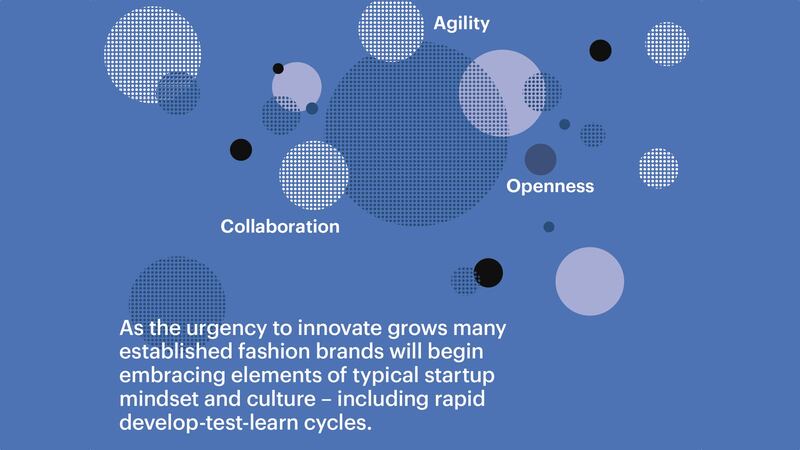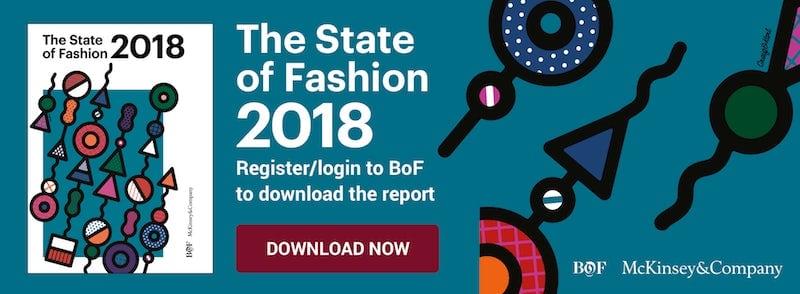
The Business of Fashion
Agenda-setting intelligence, analysis and advice for the global fashion community.

Agenda-setting intelligence, analysis and advice for the global fashion community.

The author has shared a YouTube video.
You will need to accept and consent to the use of cookies and similar technologies by our third-party partners (including: YouTube, Instagram or Twitter), in order to view embedded content in this article and others you may visit in future.
LONDON, United Kingdom — Some leading thinkers believe that within the next decade, 40 percent of Fortune 500 companies will cease to exist. As a growing number of retailers file for bankruptcy and fashion brands continue to disappear, more fashion companies are realising that survival requires constant innovation. The mantra "innovate or die" has never felt more relevant. That's why we expect fashion players in 2018 to be keenly focused on delivering innovation from design to after-sale. We will see more companies looking outside the industry for inspiration on how to infuse innovation into their entire ecosystem. Learning from the operating models of startups and digital native companies, fashion companies will be compelled to open up to new types of talent, new ways of working, new kinds of partnerships and new investment models.
One way to promote innovation is to acquire innovative startups. We expect that in 2018 the venture capital investment in the fashion ecosystem will grow and investor competition for the most attractive startups will intensify as the fashion industry's significant market size makes it ripe for further technological and digital disruption. Some of the venture capital infusion will be driven by fashion entrepreneurs. These include Miroslava Duma, who set up the hybrid venture FTL to invest in and commercialise new technologies in fashion; Net-a-Porter founder Natalie Massenet, who is setting up a fashion and lifestyle venture capital fund; and designer Rebecca Minkoff who launched a fashion tech venture capital fund in partnership with Quotidian Ventures.

E-commerce site 24 Sévres | Source: Courtesy
Large heritage players will be involved too, establishing their own venture capital arms to invest in innovative startups. Examples include LVMH Luxury Ventures, which is using its starting capital of €50 million to invest in small, promising fashion firms, and H&M’s venture capital operation which invests in young technology companies like Ivyrevel or Worn Again. Additionally, traditional VC firms will be focusing more on fashion — further fuelling the competition for the most innovative startups as they look to spot the next Stich Fix or Farfetch.
ADVERTISEMENT
The drive to innovate will intensify the war for talent amongst key players. To accelerate innovation efforts, fashion companies will need people with new skill sets, combining distinctive data analytics and technology skills with entrepreneurial mindsets. Given the dearth of such skills in the industry, fashion companies will increasingly try to hire people from the outside. Barneys New York recruited a former Facebook executive as chief information officer and Under Armour appointed General Motors’ former head of Global Advanced Design as chief innovation officer. Given that demand for individuals with those same skills is rising across all industries, fashion companies will be competing against a broad range of other companies. This raises the question for many traditional fashion companies; what is required to attract this type of talent?
Fashion players will be exploring how new collaboration models can increase the speed of innovation. There is a range of options, from cooperating with technology companies, like H&M’s collaboration with Google to leverage data insights for customised design, to partnering with academia to introduce technology and digital capabilities into fashion curriculums. We will see more traditional fashion companies adopting new approaches to boost innovation and stay successful in an increasingly competitive landscape.
Established fashion brands will begin embracing elements of typical startup mindset and culture — including rapid develop-test-learn cycles.
The fashion industry has not historically been known for rapidly adopting new working models. As David Schneider of Zalando puts it, "right now, many are a bit too closed down. A bit too centred around internal systems rather than really thinking about opening up and actually seeing, how can I collaborate with others."
As the urgency to innovate grows we believe many established fashion brands will begin embracing elements of typical startup mindset and culture — including rapid develop-test-learn cycles. The agile working model has recently emerged as a highly-effective way to spur innovation. Many large traditional companies across industries have adapted their organisational structures and practices to self-organising teams and interactive networks to improve speed, flexibility, and innovation. 24 Sèvres, the global e-commerce site of French conglomerate LVMH, runs like a startup, working in spurts according to the “release early, release often” model. The e-retailer Boohoo successfully deploys another typical startup method, “test and learn,” using data analytics test to demand for small product batches, and quickly recognising which items are selling before scaling up production. In 2018 we expect fashion companies will increasingly embrace new types of talent and investment models, and experiment with building agility and other startup working models into their organisations to drive innovation.
This article first appeared in The State of Fashion 2018, BoF and McKinsey & Company's in-depth report on the global fashion industry. Download it here.

The extraordinary expectations placed on the technology have set it up for the inevitable comedown. But that’s when the real work of seeing whether it can be truly transformative begins.
Successful social media acquisitions require keeping both talent and technology in place. Neither is likely to happen in a deal for the Chinese app, writes Dave Lee.
TikTok’s first time sponsoring the glitzy event comes just as the US effectively deemed the company a national security threat under its current ownership, raising complications for Condé Nast and the gala’s other organisers.
BoF Careers provides essential sector insights for fashion's technology and e-commerce professionals this month, to help you decode fashion’s commercial and creative landscape.